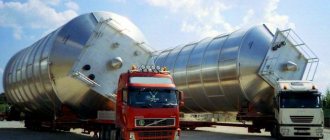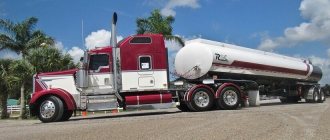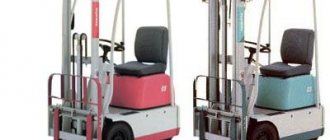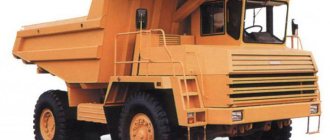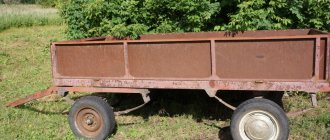Bulk cargo is used primarily in two industries - construction and agriculture. In most cases, prompt delivery to the place of its application is necessary, so all available methods are used: delivery by water, delivery of goods by road and via railway. Transportation of bulk cargo cannot be carried out using various types of transport, but the procedure itself must be carried out according to certain rules, which are directly prescribed in existing regulations.
What are bulk cargoes?
Bulk substances are a homogeneous substance, which is characterized by a certain degree of flowability. Such cargoes are divided into two types:
- Bulk ones that pour out without outside help.
- Bulk. Special mechanisms are used for unloading.
In general, the following materials can be classified as bulk cargo:
- salt;
- sugar;
- expanded clay;
- coal;
- priming;
- corn;
- various fertilizers;
- crushed stone;
- sand, etc.
Types of bulk cargo
The process of transporting this kind of material is not just delivery from point A to point B. There are certain rules for transportation, which we will talk about in a little more detail.
Types of transport
Products of the mining and metallurgical industries, and those produced for construction, must be transported by dump trucks - bulk cargo is easier and faster to unload from such a body model.
Tank trucks are also used for such transportation. They differ in their technical design and are supplemented with functions that simplify the loading and unloading process and allow them to better preserve the commercial properties of the product. Thus, some models are self-unloading, and the speed of emptying the container from the contents varies among manufacturers. They also differ in the shape of the tank, which can be funnel-shaped, cylindrical, Millenium. Transportation of bulk cargo by tank trucks with the body of the latest model is also convenient because it can transport not only cement, but also products with a larger fraction.
The funnel-shaped shape of the tank is classic for cement tankers and is valued by large carriers. The disadvantage is that the body is not completely unloaded; the remainder can reach 1.5 tons. Such tank trucks are also equipped with self-loading devices that fill the tank from warehouses of all types, railway boxcars, and ships at a distance of 25 meters.
Basic rules for transporting bulk cargo
Such issues are regulated by the “Charter of Road Transport and Urban Ground Electric Transport”. According to the third article, the transportation of bulk cargo must be carried out on the basis of the following rules:
- The surface of the bulk material should not be higher than the level of the sides of the body of the vehicle that carries out transportation. Otherwise, there is a risk of spilling onto the road.
- Preventing spillage is the main task of the party that carries out the transportation. To prevent this, a special covering (canopy) is used to cover it.
- Transportation of bulk substances in a container without packaging is strictly prohibited.
- The transported cargo must have a mass that does not exceed the carrying capacity of the transport itself.
Compliance with these rules allows you to avoid many problems during the delivery process. First of all, the company does not incur losses, because it delivers the full volume safe and sound. In addition, spillage can result not only in losses, but also in creating an emergency situation on the road, as well as damage to the road surface.
Features of transportation of crushed stone and other bulk materials
Timely delivery of bulk building materials is an important condition for high-quality and successful construction at any site. At the same time, transporting bulk materials is a complex process and requires a special approach. So, transportation of crushed stone requires special transport, for example, a dump truck or an electric forklift.
This material has a wide range of uses, and often the delivery of crushed stone is necessary not only for construction, but also for industrial production, agriculture and other things. Bulk materials are indispensable in the construction of roads, in strengthening weak soils and in the creation of reinforced concrete structures. Companies involved in the transportation of such material often offer estimates of delivery costs. Prices for transporting crushed stone and other bulk materials largely depend on the following factors:
- Duration of transportation.
- Cargo weight.
- Features of the route, complexity and length.
- Weather during transportation.
- Times of Day. Freight transportation at night often costs more than during the day.
Often crushed stone is transported using dump trucks. This type of transport is versatile and well suited for transporting bulk materials due to the fact that it is capable of lifting large loads. In addition, such freight transport allows for the transportation of cargo over long distances. So, when transporting gravel, it is necessary to take into account some important features. For example, bulk materials are poured exclusively onto the sides of dump trucks. Otherwise they may wake up. In addition, in order to prevent spillage, the car body is covered with a special awning.
The quality of transportation and the safety of the cargo, as well as the safety of drivers, largely depend on how accurately and carefully these conditions are met. After all, if the gravel falls off, this can lead to the fact that the cars driving behind the dump truck will receive mechanical damage to the windshield, body, or cause an accident.
Often, packaging bags are used to store crushed stone in warehouses. For its transportation, electric forklifts are also used, which are compact and maneuverable equipment that can transport up to approximately five tons of crushed stone. Some models have special modules, thanks to which you can efficiently capture cargo from any storage location for bulk materials. That is why human participation today is reduced to a minimum when transporting crushed stone and other bulk materials.
Regardless of the method and location of moving crushed stone, such work should be trusted only to experienced specialized workers and drivers. This way you can guarantee the safety of the transported cargo and a long service life of the equipment used.
What transport is used?
According to the charter, there are no special requirements for the type of transport carrying out transportation. This can be a truck, dump truck or other types of vehicles whose carrying capacity allows them to transport large volumes of goods. However, for the transportation of bulk substances only vehicles that meet the basic requirements are used, i.e. its body is sealed enough to transport this kind of goods.
The rules for transporting bulk cargo by dump trucks on public roads include several requirements. Thus, the dump truck must be equipped with a special stretching awning made of dense material. The purpose of this awning is to completely isolate the property being transported, so it must be very securely attached to the body.
In some cases, the absence of an awning is allowed if the surface does not exceed the level of the body sides. But even in this case, the goods must be covered with a special canopy made of thick rubberized fabric or tarpaulin. All these precautions are necessary to avoid spilling onto the road. In this case, we are talking not only about possible damage to the road surface, but also a danger to humans and animals, because some bulk cargo includes toxic elements.
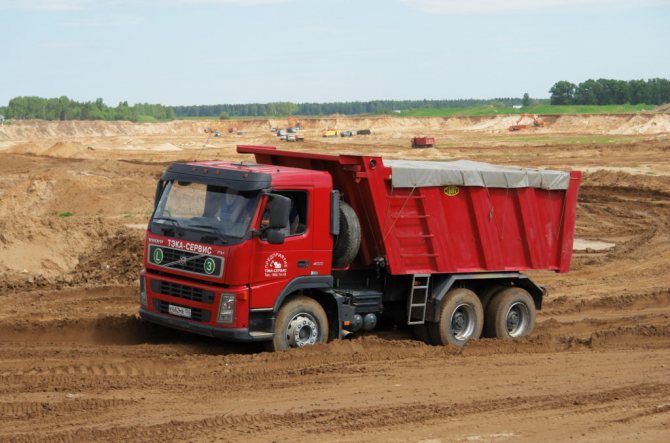
Transportation of bulk cargo on a dump truck with an awning
Naturally, if the transportation of goods by road is not carried out according to the rules, then this entails a certain responsibility. At the same time, not only the dump truck driver himself is fined, but also his immediate superior. In addition, the transportation company itself, as a legal entity, will be punished.
If the company continues to commit such violations, then the matter will not be limited to fines. In this case, the company may be temporarily prohibited from engaging in such activities until it corrects all violations in transportation.
The rules for transporting bulk cargo by motor transport on the roads of industrial enterprises allow for the absence of an awning and canopy. But even here, the level of the transported cargo should be below the level of the sides of the body for basic reasons of economy. If the vehicle has to cross the road of a populated area, which is typical when enterprise divisions are located in different places, then the vehicle must already meet the requirements for public roads.
How to properly handle bulk cargo
How to handle cargo that cannot be properly secured or packed, and even its weight is quite difficult to check? Refuse transportation? This is impossible. Grain, chalk, sand, salt and sugar, ore and building materials - without these and many other goods, the work of enterprises will freeze, and ordinary life will become very unpleasant.
In order to simplify the delivery of such substances, transport companies have included them in a separate group - bulk cargo.
The simple name reflects the specifics of transportation: these are products that are delivered in bulk, without containers.
It may seem that bulk cargo is just a subcategory within dry bulk. However, there is one “but”. In terms of their physical properties (shear resistance), bulk cargo is somewhat different from all others.
Substances consisting of many small particles are transported in bulk. Elements can be homogeneous or heterogeneous - for example, differ in size. The important thing is that they are quite mobile relative to each other and move easily. This complicates transportation. While ordinary bulk cargo can be packaged in barrels or containers, this is more difficult to do with bulk cargo. It is much easier to transport all the goods in one batch, placing them in a vehicle with a specially equipped body.
Some substances are sent without containers for safety reasons. Thus, grain during storage can self-heat and spontaneously ignite. In this case, the bag or box acts like a fur coat, maintaining a certain microclimate inside. The higher the temperature and the more foreign impurities, the higher the risk of spontaneous combustion. When transported openly in bulk, it is significantly reduced, since the grain is ventilated and does not rot.
Since Soviet times, bulk cargo has been divided into two categories - grain and non-grain. The first, in addition to cereals, also includes legumes (peas, beans, lentils, etc.), as well as oilseeds. These are peanuts, sunflowers, rapeseed and some other crops - what vegetable oils are made from.
When transporting grains, their biological properties must be taken into account. For example, grain does not just rest on its way - it can breathe, slowly ripen and even germinate! Of course, after a week of travel, it’s unlikely that a cheerfully eared body will arrive at the door of your warehouse, but it’s better not to risk it. Choose a carrier who has already worked with such cargo and is familiar with their specifics, otherwise many important things will become your long-term headache.
Each type of bulk cargo has its own transportation rules. Transport for grain delivery must meet the following requirements:
— close to ideal cleanliness, minimum dust and no foreign odors
– grain absorbs them very easily;
— low humidity level
– otherwise, the products will swell during transit and may even become moldy;
— moderate, not too high temperature
– grain is potentially capable of self-heating and spontaneous combustion, although this is a rare phenomenon;
— tightness
– thanks to mobility and fluidity, grain is able to seep and spill out even into small cracks.
To deliver grains from one region to another, special vehicles are used - grain trucks.
These can be dump trucks or regular flatbed trucks, with bodies made of steel or aluminum. The design of such machines is thought out in advance in such a way that it is convenient to unload bulk substances. Some grain trucks can unload not only backwards, but also sideways.
Regular, non-grain bulk cargo is most often transported in dump trucks. The equipment is selected according to its load-carrying capacity in accordance with the quantity of goods. The largest mining dump trucks - for transporting construction materials - can take on board 200-300 tons of cargo!
They are usually used in global construction work to deliver large volumes of crushed stone, sand, and soil.
When we choose a transportation method, economic considerations play an important role. Some substances can be transported not only in bulk, but also in other states. But delivery in bulk turns out to be the most convenient and profitable. For example, peat can be transported in “heaps”, or in briquettes. But in practice, the first method turns out to be several times cheaper than the second, if only because there is no need to spend time and money on forming briquettes.
Bulk cargo is accepted for transportation without counting the pieces, but with the obligatory indication of weight.
It must be determined by the sender. The weight is indicated on the delivery note.
Excavators and special loaders with buckets are used to load bulk materials. Dump trucks also have special devices that make loading and unloading easier. Sometimes the body is filled with bulk solids directly from a conveyor belt or other similar device - for example, when shipped from a factory.
The carrier must handle bulk cargo very carefully. Such products cannot be secured in the car. If you fill the body “all the way,” the substance may spill out through the sides on the road. The best option is if the staff has loaders trained to work with such products.
According to transportation rules, the total height of the vehicle along with the contents of the body should not exceed 4 meters - otherwise it will be considered oversized.
Of course, sending bulk cargo on the road without even a hint of packaging is unwise. Crushed stone and gravel can survive a long journey in the open without damage - without getting wet or shrinking in size. But with other products this will not work. Some types of bulk cargo - for example, cement, lime, mineral fertilizers, apatite - require reliable protection from rain and snow.
Another enemy of such substances is the wind. Its strong gusts easily blow the uncovered bulk cargo in different directions. Of course, a skeptic has the right to doubt this, but over a few hours of travel the loss can be quite significant. In addition, some products need to be protected not only from wind and dust, but also from prying eyes.
To ensure that some of your cargo does not remain on the road or in its vicinity, it is best to take measures in advance. Actually, there are not so many options: choose a covered transport for bulk substances or cover them on top with dense material. When transporting by road, the second option is often chosen. Usually machines for bulk solids are already equipped with hooks for attaching the awning. Industrial cargo and building materials are covered with tarpaulin or other suitable material. But the canopy for edible cargo needs to be chosen more carefully.
However, even in winter, bulk cargo is often transported in an open body. To prevent the goods from freezing to the bottom and sides, they are either lined with special materials or the car is equipped with a special heating system.
Covered transport is easier to use for rail shipments - there are hopper cars for bulk cargo. An alternative in the field of road transport is special containers. If the rules allow bulk cargo to be delivered in this way, the option is quite acceptable.
Prices for delivery of bulk cargo
| Name | fraction mm. | price in rubles per cube with delivery throughout Moscow and the Region |
| M*3 | ||
| sand for bedding | 1,2-2,0 | 750 |
| quarry sand | 1.2-1.8 (small) | 750 |
| quarry sand | 2.5-2.8 (large) | 750 |
| washed sand | 2,5-3,0 | 950 |
| sifted sand | 2,5-3,2 | 800 |
| coarse sand | 3 | 950 |
| pgs (up to 15% gravel) | — | 950 |
| opgs (up to 30% gravel) | — | 1050 |
| secondary crushed stone | 5-20 mm | 1200 |
| secondary crushed stone | 20-40 | 1100 |
| secondary crushed stone | 40-90 | 1100 |
| crushed limestone | 5-20 mm | 1900 |
| crushed limestone | 20-40 | 1900 |
| crushed limestone | 40-70 | 1900 |
| crushed gravel | 3-10 mm | 2050 |
| crushed gravel | 5-20 mm | 1950 |
| crushed gravel | 20-40 | 1900 |
| crushed gravel | 40-70 | 1900 |
| crushed granite stone | 3-10 mm | 2700 |
| crushed granite stone | 5-20 mm | 2800 |
| crushed granite stone | 20-40 | 2800 |
| crushed granite stone | 40-70 | 2800 |
| crushed granite stone | 25-60 | 2800 |
| expanded clay | 5-20 mm | 2400 |
| expanded clay | 10-20 mm | 2400 |
| expanded clay | 20-40 | 2400 |
| sand-soil | — | 650 |
| soil | — | 1000 |
| peat | — | 1600 |
| black soil | — | 1600 |
| soil removal | — | 600 |
| garbage removal | — | 600 |
The price of the material includes the following services:
- cargo delivery
- covering the cargo with a special canopy
- loading/unloading
- accompanying documents, certificate

